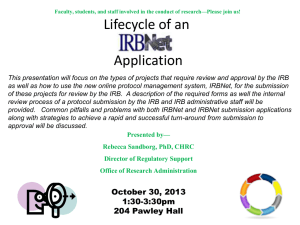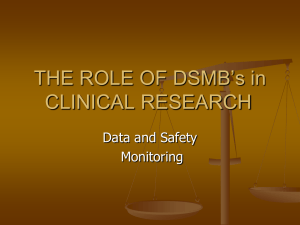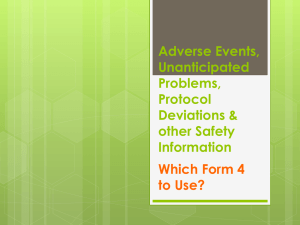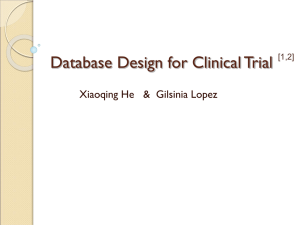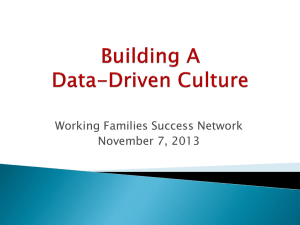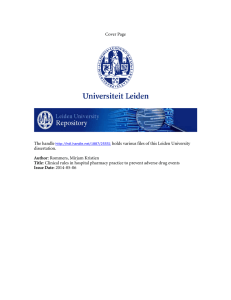Study Design - Florida Hospital
advertisement
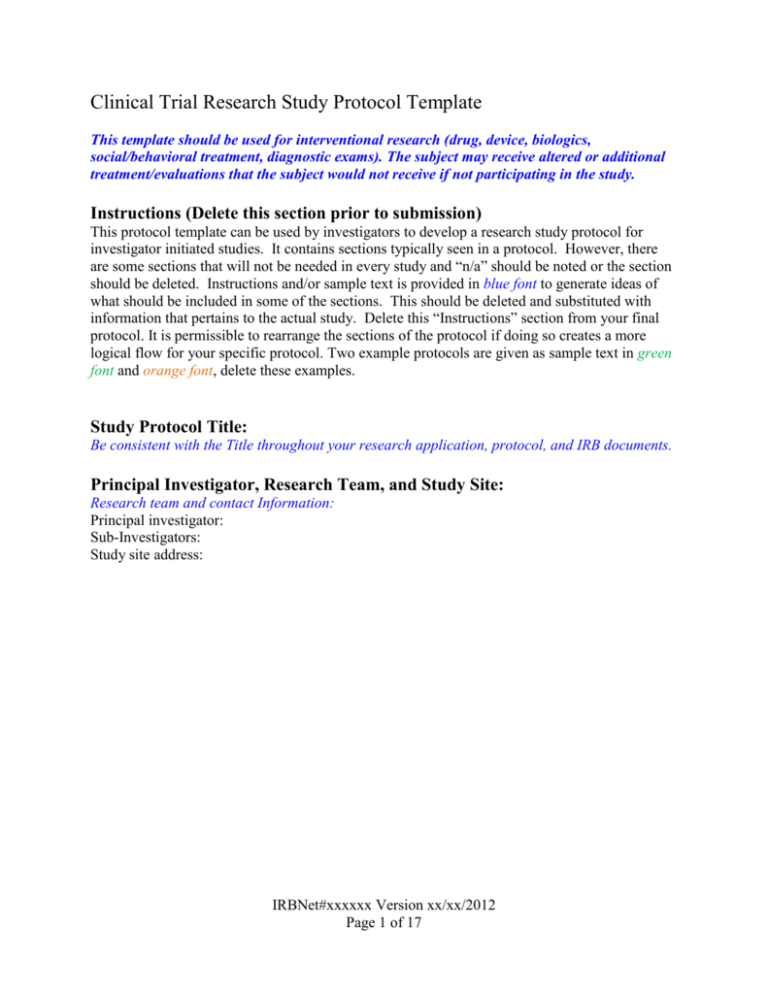
Clinical Trial Research Study Protocol Template This template should be used for interventional research (drug, device, biologics, social/behavioral treatment, diagnostic exams). The subject may receive altered or additional treatment/evaluations that the subject would not receive if not participating in the study. Instructions (Delete this section prior to submission) This protocol template can be used by investigators to develop a research study protocol for investigator initiated studies. It contains sections typically seen in a protocol. However, there are some sections that will not be needed in every study and “n/a” should be noted or the section should be deleted. Instructions and/or sample text is provided in blue font to generate ideas of what should be included in some of the sections. This should be deleted and substituted with information that pertains to the actual study. Delete this “Instructions” section from your final protocol. It is permissible to rearrange the sections of the protocol if doing so creates a more logical flow for your specific protocol. Two example protocols are given as sample text in green font and orange font, delete these examples. Study Protocol Title: Be consistent with the Title throughout your research application, protocol, and IRB documents. Principal Investigator, Research Team, and Study Site: Research team and contact Information: Principal investigator: Sub-Investigators: Study site address: IRBNet#xxxxxx Version xx/xx/2012 Page 1 of 17 Table of Contents: In order to have Word automatically create or modify your Table of Contents, do the following: 1. Make sure that any additional sections are labeled as Heading 1 (Home Tool Bar above)– put cursor at the front of the Heading and click Heading 1. Subsections should be listed as Heading 2 (Home Tool Bar above). 2. When all sections are entered, come to this page and click on the References tab, under Table of Contents, pick Update Table. Select Update entire table and click ok. List of Abbreviations: ..................................................................................................................... 4 Introduction ..................................................................................................................................... 5 Background Information and Scientific Rationale ......................................................................... 5 Summary of Previous Pre-clinical Studies/ Relevant Clinical Studies ....................................... 5 Summary of Epidemiological Data ............................................................................................. 5 Rationale ..................................................................................................................................... 5 Study Objectives ............................................................................................................................. 5 Primary Objective ....................................................................................................................... 5 Secondary Objectives.................................................................................................................. 6 Study Design ................................................................................................................................... 6 Research Design.......................................................................................................................... 6 Study Agent, Device, and/or Intervention Description ............................................................... 6 Sample Size................................................................................................................................. 7 Subject Selection ......................................................................................................................... 7 Inclusion Criteria .................................................................................................................... 7 Exclusion Criteria ................................................................................................................... 8 Study Outcome Measures (Endpoints) ....................................................................................... 8 Study Procedures ............................................................................................................................ 9 Subject Recruitment and Screening ............................................................................................ 9 Randomization ............................................................................................................................ 9 Study Visits ............................................................................................................................... 10 Study Duration .......................................................................................................................... 11 Specimen Collection, Preparation, Handling and Shipping...................................................... 11 Data Quality Plan ...................................................................................................................... 11 Statistical Analysis Plan ............................................................................................................ 11 Potential Risks and Benefits ......................................................................................................... 12 Potential Risks .......................................................................................................................... 12 IRBNet#xxxxxx Version xx/xx/2012 Page 2 of 17 Mitigation of Risks (Note: for studies with significant risk) .................................................... 12 Potential Benefits ...................................................................................................................... 12 Early Withdrawal of Subjects ....................................................................................................... 12 When and How to Withdraw Subjects ...................................................................................... 12 Data Collection and Follow-up for Withdrawn Subjects .......................................................... 13 Adverse Event Reporting: ............................................................................................................. 13 Adverse Events ......................................................................................................................... 13 Recording of Adverse Events ................................................................................................... 15 Notification of Adverse Events ................................................................................................. 15 Safety Monitoring Plan (applicable for significant risk studies) .................................................. 15 Safety Monitoring: .................................................................................................................... 15 Data and Safety Monitoring Board ........................................................................................... 15 Ethical Considerations .................................................................................................................. 16 Conflict of Interest ........................................................................................................................ 16 Funding Source ............................................................................................................................. 16 Subject Stipends or Payments ....................................................................................................... 16 Publication Plan ............................................................................................................................ 16 References ..................................................................................................................................... 17 IRBNet#xxxxxx Version xx/xx/2012 Page 3 of 17 List of Abbreviations: Use commonly used abbreviations and acronyms. IRBNet#xxxxxx Version xx/xx/2012 Page 4 of 17 Introduction The introduction should open with remarks that state that this document is a clinical research protocol and the described study will be conducted in compliance with the protocol, Good Clinical Practices standards and associated Federal regulations, and all applicable institutional research requirements. The rest of the introduction is broken out into subsections. Example language for the first paragraph under “Introduction” is given below. Sample Text: This document is a protocol for a human research study. This study is to be conducted according to United States standards of Good Clinical Practice in accordance with applicable Federal regulations and institutional research policies and procedures. Background Information and Scientific Rationale Summary of Previous Pre-clinical Studies/ Relevant Clinical Studies Summarize the available clinical study data (published or available unpublished data) with relevance to the protocol under construction -- if none is available, include a statement that there is no available clinical research data to date on the intervention being investigated. Summary of Epidemiological Data Describe the disease including incidence Rationale This section is based on your research question. How would you answer the questions and give explanations to your answer? What are the assumptions and relationships? Justification of your conducting this study based on existing knowledge and your research question. Study Objectives Primary Objective Include the details of your primary objective (which is your main purpose of performing this study and should be focused on one question), outcome measures and method by which outcomes will be determined. Sample Text: The primary objective of this study is to evaluate the efficacy of three different antibiotics in the treatment of acute bronchitis by measuring time until symptoms (fever, shortness of breath and wheezing) have cleared. Antibiotic C is currently not approved for treating acute bronchitis. Sample Text: Does having access to a “health advocate” decrease the number of hospitalizations for patients with CHF? IRBNet#xxxxxx Version xx/xx/2012 Page 5 of 17 Secondary Objectives Include secondary objectives which can be two or three can be dependent or independent of the primary objective, outcome measures and method by which secondary outcomes will be determined. Sample text: The secondary objective of this study is to assess patients overall change in symptoms and return to daily activities after 2 weeks of antibiotic treatment. Information regarding patient health history will be obtained and tested as potential predictors of outcome. Sample text: The secondary objective will be to survey the patients and advocates regarding the pros and cons of the intervention. Study Design Research Design Include the description of study type (randomized double-blinded, placebo-controlled, open/off label, parallel or crossover design), number of study arms and other study details. Include a description of the study population. If this study intends to enroll children, pregnant women, prisoners or other vulnerable populations, please check applicable sections of 45 CFR 46 for information. Type of study and design should be decided on the basis of primary and secondary objectives and availability of resources. Sample Text: This research will be carried out as a randomized double-blind trial, threearm trial. Randomization will be conducted by a qualified study member; they will be the only person with access to the randomized assignment information. Sample text: The design is a randomized prospective clinical study. Details for the study visits is provided in the study visits section of the protocol. Study Agent, Device, and/or Intervention Description (IND or Drugs) This section should contain a description of the investigational product, its make-up, chemical properties and any relevant physical properties, including any available pharmacologic data. (A good example for this section is the “Description” and “Pharmacology” sections for drugs listed in the Physicians’ Desk Reference). Describe the rationale used for selection of the dose for the protocol under construction. This should be based on non-clinical and clinical data available to date. It should include justification for route of administration, dosage, dosage regimen, and dosage period. Describe any placebo or control medications (you may refer the reader to package insert for approved medications used as a control). PLEASE INCLUDE YOUR IND NUMBER AS ASSIGNED BY THE FDA. IRBNet#xxxxxx Version xx/xx/2012 Page 6 of 17 (IDE or devices) This section should contain a description of the investigational device, design, and function, including all components, principles, elements and properties. (An example would be the information included in the IDE application to the FDA). Include any control devices used (you may refer the reader to the device instructions/manual for approved devices used as a control), if applicable. PLEASE INCLUDE YOUR IDE NUMBER AS ASSIGNED BY THE FDA. (Social or behavioral) This section should contain a description of the treatment or intervention given to each group. You may refer the reader to additional reference information for a detailed description of the intervention and/or control. Sample Text: Antibiotic A and B are FDA approved for the indication of acute bronchitis. See package insert for medication details. Antibiotic C is FDA although approved for various upper respiratory infections; it is not currently approved for acute bronchitis. See package insert for medication details. The IND number for antibiotic C is xxxxxx. Sample Size Include total number of subjects for the study including other sites. Include sample size plus an estimate for screen failures. Describe how the sample size was determined for this study. The sample size should be based upon the primary outcome variable. If the authors have determined that sample size estimation was not computed, please provide the rationale. Sample Text: The primary outcome measure is time (hours). For this particular study there is an estimated mean difference of approximately 4 hours between at least two of the three antibiotics. Antibiotic x is currently not approved for acute bronchitis. Using this information along with an estimate of variability, a sample size of 24 patients for each group was calculated using power of 80% and an alpha value of 0.05. Sample text: The anticipated patient population available is 450 patients per year. The study enrollment period will be one year and 40% of eligible patients are expected to enroll. Approximately 200 patients will be enrolled in the study. Subject Selection Inclusion Criteria Create a numbered list of criteria subjects must meet to be eligible for study enrollment (e.g. age, gender, target disease, concomitant disease if required, etc.) Generally should include items such as: “subjects are capable of giving informed consent,” or if appropriate, “have an acceptable surrogate capable of giving consent on the subject’s behalf.” You should consider clinical aspects that are appropriate for your protocol such as: number of symptoms and length and/or severity of symptoms. IRBNet#xxxxxx Version xx/xx/2012 Page 7 of 17 Sample text: 1. Age 18 – 89 2. Primary diagnosis of acute bronchitis (ICD-9:466.0) 3. Able to provide informed consent Sample text: 1. Age 18 – 89 2. Diagnosis of Chronic Heart Failure (CHF) 3. NYHA classification I - III 4. Able to provide informed consent 5. Willing and able to provide a contact phone number 6. Confirm availability for study inclusion Exclusion Criteria Create a numbered list of criteria that would exclude a subject from study enrollment. If appropriate, should generally include that subjects have active drug or alcohol dependence or abuse history or would interfere with study participation. If exposure to certain medications or treatments at screening is prohibited, that must be noted in the exclusion criteria—if these are also prohibited concomitant medications during the study period that should be noted here as well. You should consider clinical issues that are appropriate for your protocol such as: contraindications to the study interventions, abnormal lab results, or history of cancer. Sample text: 1. Known allergies to the study medications. 2. Lives more than 50 miles from Dr. Xyz’s medical practice office 3. Diagnosed with any of the following co-morbidities (list here) Sample text: 1. NYHA classification IV 2. Lives more than 50 miles from study center 3. Diagnosed with any of the following co-morbidities (list here) Study Outcome Measures (Endpoints) In this section, provide a list of the endpoint variables to be studied along with a description (and reference) of the endpoint variable. If the outcome measure is a nonstandard of care item that cannot be billed to an outside payor (please notate as such). Sample Text: Body Temperature: Temperature will be taken at 4 times each day using a digital oral thermometer. Data collection will indicate method and measurement scale used for temperature readings. Sample Text: Shortness of breath: Shortness of breath will be measured twice a day at (12:00 PM ± 1 hour and 6:00 PM ± 1 hour) using the Dyspnea Index (see Appendix). The scale is from 0 to 4, with 4 being the highest indication of shortness of breath. IRBNet#xxxxxx Version xx/xx/2012 Page 8 of 17 Sample Text: Wheezing: Wheezing will be measured using a peak flow meter twice a day at (12:00 PM ± 1 hour and 6:00 PM ± 1 hour).The numerical value is the peak expiratory flow rate (PEFR) Sample Text: Subject Information: Patient information will be obtained using a paper questionnaire 2 weeks (plus 2 days) after starting antibiotic treatment. Questions regarding returning to normal activity as well as basic demographic information will be collected. Demographic information of age, gender, employment and smoking status will be self-reported items on the questionnaire. Sample Text: Number of hospitalizations: Count of the number of admissions during a 12 month period starting with patient enrollment in the study. Sample Text: Pros and Cons of the intervention: Information on the pros and cons of the intervention will be solicited from all patients and advocates involved with the study. This information will be gathered (audio recorded) by trained interviewers using five standard questions during an approximately 15 minute interview. Interview questions are listed in Appendix B. Data storage, retention, protection of confidentiality and disposal for all data collected on any media type (e.g., audio recordings, video recordings, blogs, digital or still photographs) should be addressed. Study Procedures Subject Recruitment and Screening Describe how subjects will be recruited for the study, e.g. from investigator or subinvestigator clinical practices, referring physicians, advertisement, etc. Note in this section that information to be disseminated to subjects (handouts, brochures, etc.) and that any advertisements must be approved by the IRB for the site; include a sample of such information in the attachment section of the protocol. You may list any screening requirements such as laboratory or diagnostic testing necessary to meet any noted inclusion or exclusion criteria. However, this information should also be listed in the “Study Design/Subject Selection” section of the protocol. Sample Text: Participants will be recruited from the clinical practice of Dr.Xyz that have been seen at the office. Informed consent will take place in the office, after diagnosis by a research team member listed on the IRB team tracking log. Sample text: Participants will be recruited from patients admitted to Florida Hospital, South campus with the primary diagnosis of CHF. Informed consent will take place after hospital admission by a research team member listed on the IRB team tracking log. . Randomization Describe how subjects are going to be randomized. IRBNet#xxxxxx Version xx/xx/2012 Page 9 of 17 Sample Text: Randomization will be done using statistical software by a trained team member. This information will only be released as the patients are enrolled. A master list of the patient names and intervention group will be kept in a locked file drawer at the study site. Sample text: Patients will be randomized to an advocate or to the control group. Patients in the treatment group will be assigned an advocate on a rotating basis, so that each advocate has approximately the same number of patients. Study Visits In this section, describe all the procedures and treatments required at each visit, broken out by visit. Create a study procedures flowchart/table that describes the activities and procedures to be followed at each visit. Include this flowchart/table in the Attachment section and refer to that attachment in this section. Include a projected start date. Provide the total length of time participants will remain in the study including the active intervention and follow up period. Include an approximate end date of the study. Sample Text: ITEM Screening Inclusion and Exclusion Criteria Informed Consent Randomization Temperature readings Shortness of Breath Wheezing Questionnaire X x x Treatment Period (2 weeks) Two weeks (+2 days) after initial visit X4 X2 X2 X Sample text: After patients have been screened and signed informed consent, those in the treatment group will be assigned an advocate (rotating basis). There will be six advocates assigned to this study. Patients in the control group will be provided standard medical treatment for CHF patients. On the first day of the patient’s hospital stay, the advocate will visit the patient and discuss what services are available. This will be recorded an electronic text entry. Services that may be provided are: educational videos on CHF, visit from a registered dietitian, smoking cessation program information, general health counseling and assistance setting up additional physician appointments. On each following day the person is in the hospital, the advocate will visit at least one time and document electronically the content of the discussion. After returning home, the patient will receive a phone call within 2 weeks (add), with calls once a month (add) for 11 more months. This will be not change with subsequent hospitalizations. Control group patients will receive a phone call at the end of one year. IRBNet#xxxxxx Version xx/xx/2012 Page 10 of 17 Study Duration Define the length of time each individual subject will be followed. Also specify the approximate length of time to enroll subjects in the study until the completion of the study (time should encompass statistical analysis and publication). Sample Text: Patient participation will last approximately 2 weeks. Rolling admission for 72 patients should take approximately 1 year to complete enrollment, data collection and analysis. Sample text: Patients will be followed for 12 months. Study Duration will last 3 years. Specimen Collection, Preparation, Handling and Shipping If applicable, provide summary information. Check Standard Operating Procedures for Florida Hospital regarding applicable policies. If hazardous materials (e.g., lab specimens, dry ice, etc...) will be shipped and/or transported from the study site, only International Air Transport Association (IATA) certified personnel may prepare the materials for transport. Note: Contact FH laboratory services for information regarding IATA certification training. Data Quality Plan Describe how the data quality is going to be checked. Sample text: Quality control procedures for this research study include source data verification by randomly selecting 10% of subject records with comparison between the paper case report form (CRF) and the electronic database record of those same data. If errors are common, data will be completely checked prior to data analysis. Statistical Analysis Plan Summarize the overall statistical approach to the analysis of the study. The section should contain the key elements of the analysis plan, but should not be a reiteration of a detailed study analysis plan. The full Statistical Analysis Plan can then be a “standalone” document that can undergo edits and versioning outside of the protocol and therefore not trigger an IRB re-review with every version or edit –AS LONG AS THE KEY ELEMENTS OF THE ANALYSIS PLAN DO NOT CHANGE. The key elements should be described in this section. Be clear on primary as well as any applicable secondary analyses for Primary Aims and Secondary Aims. Sample Text: Demographic and baseline levels of all clinical outcome variables or endpoints will be compared between the three treatment groups using analysis of variance (ANOVA) for comparison of group means or an appropriate comparison test. IRBNet#xxxxxx Version xx/xx/2012 Page 11 of 17 Sample text: The number of hospitalizations will be compared for the treatment and control groups using appropriate statistical methods. Pros and cons expressed by patients and advocates will be summarized using qualitative data analysis methods and software. Potential Risks and Benefits Potential Risks Describe potential risks (physical, psychological, social, or any other risk) to individuals participating in this study. Sample Text: Patients may have unknown allergies to one or more of the study antibiotics and an adverse reaction may occur. Loss of privacy in regards to health information collected as part of this study is an anticipated potential risk. Sample text: Patients could possibly have emotional difficulty dealing with health information provided by the advocates. There is a potential risk regarding loss of privacy. Mitigation of Risks (Note: for studies with significant risk) Describe what procedure will be implemented to reduce subject risk. Sample Text: Patients will be monitored closely (phone call within 24 hours) to ascertain any possible side effects related to study antibiotics. Sample text: Advocates will monitor patient reaction and provide access to counseling if the patient requests this type of support. Potential Benefits Describe potential benefits to the individual research subject (economic, physical, or other) as well as the benefits to science for this clinical trial. Sample Text: Patients will be monitored closely (phone call within 24 hours) to ascertain any possible side effects related to study antibiotics. Sample text: Advocates will monitor patient reaction and provide access to counseling if necessary. Early Withdrawal of Subjects When and How to Withdraw Subjects Describe the scenarios under which a subject may be withdrawn from the study prior to the expected completion of that subject (e.g. safety reasons, failure of subject to adhere to protocol requirements, subject consent withdrawal, disease progression, etc.) Also, if abrupt termination of study treatment could affect subject safety (e.g. in an antihypertensive study, abrupt withdrawal without other intervention might cause IRBNet#xxxxxx Version xx/xx/2012 Page 12 of 17 hypertensive rebound), describe procedure to transition subject off the study drug or to alternate therapy. Sample Text: Patients that did not complete the full course of antibiotics (e.g., adverse reaction, exacerbation requiring additional treatment or non-compliance) will be removed from the study. If patients are unable to complete the two weeks of antibiotic treatment, data collection will not continue but they will still be counted in the patient numbers and a reason will be recorded on the CRF. Sample text: The number of hospitalizations will be compared for the treatment and control groups using appropriate statistical methods. Pros and cons expressed by patients and advocates will be summarized using qualitative data analysis methods and software. Data Collection and Follow-up for Withdrawn Subjects Even though subjects may be withdrawn prematurely from the study, it is imperative to collect at least survival data on such subjects throughout the protocol follow-up period for that subject (though careful thought should be give to the full data set that should to be collected on such subjects to fully support the analysis). Such data is important to the integrity of the final study analysis, since early withdrawal could be related to the safety profile of the study product or intervention. IT MUST BE A HIGH PRIORITY TO TRY TO OBTAIN AT LEAST SURVIVAL DATA ON ALL SUBJECTS LOST TO FOLLOW-UP, AND TO NOTE WHAT METHODS SHOULD BE USED BEFORE ONE CAN STATE THE SUBJECT IS TRULY LOST TO FOLLOW-UP (e.g. number of phone calls to subject, phone calls to next-of-kin if possible, certified letters, etc.). Sample Text: Patients will be contacted via phone, for a follow-up appointment – approximately 3 days after the 2 week treatment. If patients cannot return for follow-up they will be sent a paper questionnaire to complete and return. A total of 5 phone calls and 2 paper questionnaires will be sent prior to concluding the patient is lost to followup. Sample text: At any point during the year of enrollment that the patient’s phone number is no longer valid, an internet search will be used to identify a new phone number. A certified letter will be sent to the address and effort will be made to determine if the patient has died prior to the conclusion of the study. Adverse Event Reporting: Adverse Events An adverse event (AE) is any untoward or unfavorable medical occurrence in a human subject, including any abnormal sign (for example, abnormal physical exam or laboratory finding), symptom, or disease, temporally associated with the subject’s participation in the research, whether or not considered related to the subject’s participation in the research. IRBNet#xxxxxx Version xx/xx/2012 Page 13 of 17 Adverse events will be documented as anticipated or unanticipated; minor or serious; and, related or unrelated to study intervention. List all adverse events, and if possible, identify serious adverse events separately. Serious Adverse Event (SAE): A Serious Adverse Event is defined as an AE meeting one of the following outcomes: Death during the period of protocol defined surveillance Life Threatening Event (defined as a participant at immediate risk of death at the time of the event) Inpatient hospitalization or prolongation of existing hospitalization during the period of protocol defined surveillance Results in congenital anomaly or birth defect Results in a persistent or significant disability/incapacity Define any other Serious Adverse Event (SAEs) based on the specifics of the study. All adverse events that do not meet any of the criteria for serious, should be regarded as minor adverse events. A preexisting condition is one that is present at the start of the study. A preexisting condition should be recorded as an adverse event if the frequency, intensity, or the character of the condition worsens during the study period. If relevant to the study, a clinical laboratory abnormality should be documented as an adverse event if any one of the following conditions is met: The laboratory abnormality is not otherwise refuted by a repeat test to confirm the abnormality The abnormality suggests a disease and/or organ toxicity The abnormality is of a degree that requires active management; e.g. change of dose, discontinuation of the drug, more frequent follow-up assessments, further diagnostic investigation, etc. If relevant to the study, any adverse event that results in hospitalization or prolonged hospitalization should be documented and reported as a serious adverse event unless specifically instructed otherwise in this protocol. Any condition responsible for surgery should be documented as an adverse event if the condition meets the criteria for and adverse event. Neither the condition, hospitalization, prolonged hospitalization, nor surgery are reported as an adverse event in the following circumstances: Hospitalization or prolonged hospitalization for diagnostic or elective surgical procedures for a preexisting condition. Surgery should not be reported as an outcome of an adverse event if the purpose of the surgery was elective or diagnostic and the outcome was uneventful. Hospitalization or prolonged hospitalization required to allow efficacy measurement for the study. IRBNet#xxxxxx Version xx/xx/2012 Page 14 of 17 Hospitalization or prolonged hospitalization for therapy of the target disease of the study, unless it is a worsening or increase in frequency of hospital admissions as judged by the clinical investigator. Include methods and timings for assessing, recording, and managing adverse events and safety parameters Recording of Adverse Events Sample Text: At each contact with the subject, the investigator will seek information on adverse events by specific questioning and, as appropriate, by examination. Information on all adverse events should be recorded immediately in the source document, and also in the appropriate adverse event module of the case report form (CRF). All clearly related signs, symptoms, and abnormal diagnostic procedures results should recorded in the source document. Notification of Adverse Events Sample Text: All adverse events will be reported according to Florida Hospital IRB guidelines. If study is sponsored, consult with sponsor regarding guidelines for reporting and include this information in your protocol. Safety Monitoring Plan (applicable for significant risk studies) Safety Monitoring: Monitoring is an ongoing review of the study throughout its duration. Plans for collecting data and protocol compliance should be included. The PI is responsible for reporting any reasons outside the planned study design such as noncompliance with the protocol or if there is any delay in the initiation of the study due to administrative reasons. Data and Safety Monitoring Board If there is no internal DSMB, delete this section. An Internal Data and Safety Monitoring Board (DSMB) is a group of professionals, experienced in clinical care and/or clinical research, assembled to provide additional safety and oversight to a clinical study. This type of oversight committee includes medical and scientific experts and may include clergy, statisticians and other nonmedical experts. These members may not be part of the study team. The DSMB will look only at de-identified data. This section should describe the above noted DSMB attributes. Number of members and roles (e.g. clinicians, biostatisticians, bioethicists, etc.). It is not necessary to list the names or contact information of DSMB members in the protocol. However, the names and contact information of DSMB members should be reported to the IRB and also maintained in the regulatory files. IRBNet#xxxxxx Version xx/xx/2012 Page 15 of 17 How often the DSMB will meet (and if by phone, face-to-face, or web-assisted conferencing) Type of safety information that will be assessed How the safety data will be supplied to the DSMB Summary of number and type of safety assessments the DSMB will conduct How the DSMB will record the summary of its various meetings How the DSMB will report its findings and/or recommendations, and to whom Reference the DSMB charter in the Attachments section of the protocol Ethical Considerations Identify any ethical concerns and how you will address these. Address subject rights such as, allowing subjects in the control group access to the treatment after study completion, if appropriate. Note: If including or targeting vulnerable populations explain additional measures you will implement in order to protect their rights. Conflict of Interest Note: Florida Hospital requires every investigator to complete a Conflict of Interest form every 12 months and update as needed. If a real or perceived conflict of interest is identified (by ORA staff), describe the conflict of interest management plan. Funding Source This section should describe how the study will be financed, but should not contain specific dollar amounts (e.g. “This study is financed through a grant from the US National Institute of Health”, or “… a grant from the American Heart Association”, etc.) Subject Stipends or Payments Describe any subject stipend or payment or gift here. If there is no subject stipend/payment, state that participants will not be reimbursed for their participation. Publication Plan Describe the plan for publication. Note: To the extent possible, roles and responsibilities of each research team member should be determined in advance. Additionally, if the research study will be published, there should be an additional plan that describes assignment of authorship and the contributions of each author. International Committee of Medical Journal Editors (ICMJE) has a policy to guide authorship; the details are provided on the ORA website under Protocol Development tab (Worksheet for Identifying Investigators and Authorship.doc) https://drupal02.floridahospital.org/researchadmin/content/research-types IRBNet#xxxxxx Version xx/xx/2012 Page 16 of 17 References This is the bibliography section for any information cited in the protocol. It should be organized as any standard bibliography. 1. Author, Title of work, periodical and associated information. 2. Author, Title of work, periodical and associated information. Note: Appendices should be included after references. IRBNet#xxxxxx Version xx/xx/2012 Page 17 of 17
